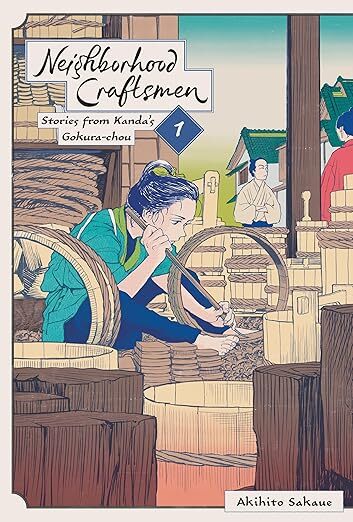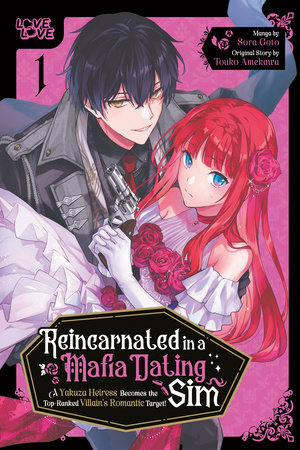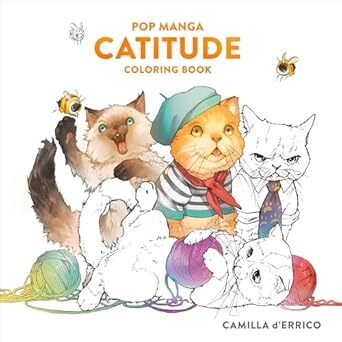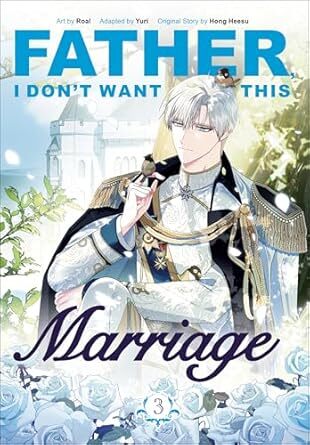S.Q. Eries's Blog
October 21, 2025
Manhwa Review: My Life as an Internet Novel Vol. #1
There’s a ton of life do-over stories on the market, whether via time slip, reincarnation, or isekai. And in My Life as an Internet Novel, nothing actually happens for the main character to end up in a fictional world. She just wakes up in it! Read on for my review of Volume 1.
Back Cover Blurb
Every internet novel has the usual cast: a gorgeous heroine, handsome boys vying for her attention, and a unremarkable best friend at the heroine’s side. Dani, an ordinary student and avid reader, is all too familiar with these tropes. But she never imagined that one day she’d wake up in one herself!
The ReviewOn the first day of school, 14-year-old Dani Hahm wakes up to discover her mundane navy-colored school uniform has been replaced by a gaudy outfit befitting a web comic. Next, a gorgeous stranger comes to her front door in the same outfit and claiming that she’s her best friend. And when they arrive at their school (whose names and buildings have inexplicably changed), Dani encounters four stunning guys with hair and eye colors that do not match their Korean facial features. Somehow, Dani’s ordinary life has switched to an Internet novel– with her in the role of the heroine’s sidekick!
Although this has the feel of an isekai, it technically isn’t one. Dani has not died nor has been transported to another world. She is still in the same apartment and neighborhood where she’s lived all her life, and her mother is also the same person. What has changed is that the Internet novels she loved to read no longer exist, and the stereotypical elements of those stories have manifested in real life. For instance, all schools have their own Four Heavenly Kings, that is, a cohort of four super-popular male hotties.
The first quarter of this book is Dani struggling to make sense of this new reality. The second is Dani making the decision to avoid getting caught up with her school’s Four Heavenly Kings and heroine. Although she is a fan of such stories, she’s sensible enough to know that actually living that kind of drama is a pain. So when she realizes that Yeoryeong –her supersmart, beautiful neighbor, who is strangely ostracized by everyone at school except the Four Heavenly Kings–is the protagonist character, Dani resolves to keep her distance. Unfortunately, Yeoryeong insists that Dani is her best friend and won’t stop pursuing her.
Then the story moves ahead three years in a time skip that quite honestly threw me for a loop. Because most of the initial interaction is between Dani and Yeoryeong, we don’t get to learn much about the Four Heavenly Kings beyond the basics. And with the time skip, the two girls and four boys are abruptly depicted as a tight-knit group, and the details of how their friendship formed are belatedly shown in flashbacks.
It’s a storytelling decision that doesn’t particularly appeal to me. Especially since the flashbacks clarified only the relationship between the girls. Throughout the majority of this volume, the boys seem as if they’re simply to fill the backdrop as the “cute hottie,” “friendly hottie,” “icy hottie,” and “antagonistic hottie.”
The other thing about the plot is that I’m not entirely sure where it’s going. After the time skip, it appears that Dani, much like Katerina from My Next Life As a Villainess, is the character everyone’s actually in love with although she’s completely unaware of that fact herself. However, Katerina always had her mind on the Bad Ends of the game she was reincarnated into. With Dani, she’s not in the storyline of any particular novel, and while she does get caught up in some drama from being around Yeoryeong, none of it classifies as Death Flag danger. Without any particular goal or threat, Dani just winds up being a normie with a dazzling mixed harem after her.
Illustrations are rendered in full color on glossy paper, which makes for a nice-looking but hefty book. Artwork is average; the only reason you know Yeoryeong and the Four Heavenly Kings are extraordinarily good-looking is because of the reactions of other characters. Cultural references are explained in footnotes. Extras include Volume 2 preview.
In SummaryIt’s a Mary Sue in the land of Internet Novel tropes! Unfortunately, its premise isn’t exactly original, and our tropey characters are unfortunately two-dimensional. While it looks like the next volume has more character development in store, this initial volume’s single twist of Dani meaning more to Yeoryeong than simply a “best friend” doesn’t make for a particularly compelling read.
First published at the Fandom Post.
October 7, 2025
Manga Review: Neighborhood Craftsmen Vol. #01
Historical fiction is often about larger than life heroes and royalty. But what about common folk? Yen Press’ Neighborhood Craftsmen: Stories from Kanda’s Gokura-chou focuses on the lives of ordinary tradesmen with exquisite detail. Read on for my review.
Back Cover Blurb
Whether it’s household goods or clothing or their very homes, the people of the Kanda neighborhood in the city of Edo depend on the expertise of local craftsmen. These artisans have years of experience perfecting their craft, but there’s always room for them to learn and experiment, developing new techniques that will take their work to even greater heights. Step into the exquisitely illustrated workshops of a cooper, swordsmith, dyer, weaver, and plasterer and witness the traditional techniques on which modern Japan was built.
The ReviewKanda is a historical area of Tokyo. During the days of samurai, the city was called Edo, and within each of Kanda’s neighborhoods, local craftsmen used their skills to meet the needs of residents. One such neighborhood was Gokura-chou, whose artisans not only honed traditional techniques but also developed new ones to enhance their craft.
If you enjoy historical slice of life à la Kaoru Mori, Neighborhood Craftsmen is definitely worth a look. Like Mori-sensei’s works, the attention to visual details is exquisite, whether the wood shavings on a cooper’s floor, the tools hanging on a swordsmith’s wall, or the different sections of an Edo-era brothel. It’s also apparent that the setting and featured trades were meticulously researched by the creator.
The biggest difference between Neighborhood Craftsmen and Mori-sensei’s works is that there is no central or overarching storyline. Rather, it’s a collection of vignettes. In fact, the first three stories begin with, “This is a day in the life of a craftsman in Kanda,” and the fourth story might as well start with that same line. Unlike the others, the final story takes up three chapters instead of one, but that’s because it follows a plasterer and her crew over the months-long construction of a storehouse.
But while the techniques of these traditional Japanese crafts get the spotlight, Sakaue-sensei frames them against the vivid tapestry of life in this fictional neighborhood. The cooper in Chapter 1 dishes out advice as she repairs damaged pails and builds new ones. The swordsmith in Chapter 2 is driven to create an unusual sword in the aftermath of a tragedy. The indigo dyer of Chapter 3 seeks inspiration to help her out of a creative rut. The tatami weaver in Chapter 4 plies his trade at a pleasure district brothel amid its gorgeous workers and their clients. And the lead plasterer of the final story butts heads with another master of the trade and struggles to keep her subordinates in line in a high-visibility construction project.
That’s another thing about this book. Except for the tatami weaver, all the protagonists of these vignettes are female. I’m not certain how historically accurate that is for a woman to rise in the ranks in the swordsmithing and plasterer trades. However, the plasterer’s story does address the difficulties a female boss has in wielding authority over male subordinates in that industry.
Because the stories do get into the weeds with aspects of these crafts, there are a bunch of trade-specific terms that come up in the narrative. On top of that, it’s a historical, which brings in another set of vocabulary that most modern Western readers won’t know. The translation notes at the back do a good job of covering these references, but it does get a bit dense, so be warned.
Yen Press beautifully produced this title as a hardback with a full-color dust cover and matte pages.
In SummaryNeighborhood Craftsmen is a real gem from a visual and storytelling perspective. The short story, slice-of-life format may not appeal to everyone, but its vignettes of Edo craftsmen showcase their various trades in an engaging and entertaining way. If you’re interested in traditional Japanese crafts or the lives of ordinary townsfolk in this era, pick it up!
First published at the Fandom Post.
September 30, 2025
Manga Review: Suzuki-kun’s Mindful Life Vol. #01
“Don’t judge a book by its cover,” is how the saying goes, but people do it all the time. Manga is full of characters whose outward appearances don’t match their inner selves, and Yen Press’ Suzuki-kun’s Mindful Life is a lighthearted high school series with such a cast. Read on for my review.
Back Cover Blurb
Looks can be deceiving. After all, one glance at the towering and intimidating Kaoru Suzuki is enough to send people packing…and get others riled up for a fight. But the guy’s actually a softie inside, as well as a flower lover and an avid baker, to boot! When Suzuki gets harassed on the train, a delicate but unexpectedly tough boy swoops in to save the day. This unlikely duo kicks off a friendship that proves that what you see isn’t always what you get!
The ReviewKaoru Suzuki spent his middle school years as an outcast. Although he looks like a thug with his gargantuan body and intimidating features, he’s actually a softy who enjoys baking and home crafts. Unfortunately, that combination got him branded as a creep by schoolmates. So when he starts high school, he anticipates more the same. However, his social life takes a radical turn for the better when diminutive classmate Arata Haruna bails him out of a tight spot. Like Kaoru, Arata has an appearance that does not match his personality, and not only does he befriend Kaoru, he helps their classmates see past Kaoru’s scary exterior to the nice guy inside. Will Kaoru finally get the school life that he’s always dreamed of?
Suzuki-kun’s Mindful Life reminds me of the Otomen series from the aughts, which also has a macho-looking main character who loves girly things, and a feminine-looking costar with a very masculine personality. But whereas the Otomen costar is a female love interest, Kaoru’s costar is a guy friend whose small stature and cute face belie his judo skills and confident personality. Also, Otomen‘s Asuka gives off more of a maidenly vibe, but the impression Kaoru gives is that of a stay-at-home mom.
And no, it’s not a BL. In Chapter 2, Kaoru develops a crush on Sakurako, a teacher at his little sister’s preschool. It’s completely innocent, one-sided, and what you might expect from a boy his age. And when Sakurako-sensei joins Arata’s dojo, he is also overwhelmed by her pretty looks.
If I had to classify the title, I’d say it’s a lighthearted high school slice-of-life with characters whose outward appearances give other people the wrong impression about them. Overall, the vibe is positive and funny. Although Kaoru is essentially friendless until he meets Arata, he has an extremely supportive family. His mother encourages and appreciates Kaoru’s domestic pursuits, and little sister Tamako absolutely adores her giant big brother. And once Arata befriends Kaoru, Arata gives him the push he needs to break out of his shell. Plus, Arata bridges the gap between Kaoru and their classmates when the situation calls for it. And as Kaoru shows more of his true self to his classmates, the juxtaposition between his appearance and the strong “mom” vibe he gives off is pretty funny. The contrast between his tough, mature looks and his innocent crush on Sakurako-sensei is also hilarious.
By the way, Sakurako-sensei, like the two boys, is not all she seems. She is a hard-drinking, hard-core gamer. Not that that’s illegal, but because her job entails childcare, she doesn’t want her students’ families seeing her as anything but wholesome.
Right now, it’s uncertain what the overarching arc of this series is. However, Kaoru is definitely a protagonist that I can root for. The interactions he has with his family and with Arata are fun and engaging, and the accompanying visuals are entertaining.
Artwork is about average, generally speaking, but expressions are on point for the comic scenes. Extras include a preview of the next volume and translation notes.
In SummaryIf you like your protagonists big and scary-looking on the outside yet sweet and sensitive on the inside, give Suzuki-kun’s Mindful Life a try. Kaoru is adorably awkward as his meek personality and domestic pursuits clash with his gangster appearance. While it looks like he may have to face some old demons in the future, the other characters create a wonderfully supportive vibe, which makes for a positive, heart-warming story.
First published at the Fandom Post.
September 2, 2025
Manga Review: Reincarnated In A Mafia Dating Sim Vol. #1
There’s a ton of life do-over stories on the market, whether via time slip, reincarnation, or isekai. LoveLove‘s Reincarnated In A Mafia Dating Sim takes the reincarnation route. Read on for my review of Volume 1.
Back Cover Blurb
When the granddaughter of a yakuza boss is reincarnated as Francesca Calvino, the heroine in a mafia dating video game — set in a fantastical world where crime bosses serve the king — she knows what to expect: another ill-fated life without friends. But thanks to her upbringing, she’s already hatched a plan. By expertly navigating the game’s main story, Francesca will leave the world of organized crime behind for good!
First on her agenda: break off her engagement to the notorious Leonardo Aldini, the young head of the Aldini family and major villain of the game. But after breezing through her kidnapping without a male lead in sight, Francesca proves herself to be a little too good at taking Leonardo on. Not only does he still wish to marry, but he won’t leave her alone.
How is Francesca supposed to live a normal life while being pursued by an insolent crime lord?
The Review17-year-old Francesca Calvino is not merely the daughter of the don of one of the kingdom’s most powerful criminal families. She’s the reincarnation of a yakuza boss’ granddaughter. And having been reborn as “Francesca,” the main character of a popular Mafia dating sim, she’s determined to use her knowledge of the game to get the normie life she never experienced in her previous existence. Unfortunately, her attempts to escape the world of organized crime hit a snag when the game’s chief villain, Leonardo Aldini, sets his romantic (?) sights on her.
The setup for the story is similar to many game reincarnation isekai. The protagonist gets reborn as a character with an undesirable fate and has to use her knowledge of the game to avoid said fate. However, Francesca’s not so much out to escape a “Bad End” as she is to escape the role she was born into. While many stories in this genre gloss over the protagonist’s previous life, Reincarnated in a Mafia Dating Sim devotes 15 pages of the opening chapter to the protagonist’s friend-starved existence in a yakuza household. In doing so, the narrative establishes two things. First, her organized crime smarts, which the overly sheltered “Francesca” of the video game did not possess. Second, her desire to escape the mob life, which motivates all her actions in the story.
Also introduced in this initial chapter are, of course, the premise and particulars of the game, which are kind of complicated. People use guns over swords, and those with noble bloodlines can use magic. The setting is a European-style kingdom where the monarchy is supported by five noble houses that also control the Underworld. Logically speaking, I don’t get how criminal families would cooperate in a monarchy system this way (unless the whole system is rotten), but in our protagonist’s previous life, her grandfather was supposedly an “honorable mob boss.” So the entire work romanticizes organized crime quite a bit. And because it is a dating sim, the protagonist’s love interests all come from the aforementioned noble mobster houses, and their interactions take place in an academy setting.
Because of all the backstory and explanations, our male lead, Leonardo Aldini, doesn’t make his dramatic entrance until page 60. And once he hits the scene, there are more explanations about him. He is the head of the Aldini family. He assumed leadership at age 10 when his father and older brother were killed. He has a reputation for genius, charisma, and ruthlessness. And due to an old promise between their grandfathers, Leonardo and Francesca are engaged. However, the game storyline pits him as Francesca’s enemy, so their first interaction is his kidnapping her the day before school starts for nefarious purposes.
But because Francesca doesn’t act as he predicts, he falls for her… I think. Despite the ton of information provided about him, it’s hard to tell what he’s really after. I believe it’s an attempt by the creator to make him mysterious, but he just comes off as baffling. Francesca’s attitude toward him is also baffling. She describes him as the kingdom’s greatest threat but goes way out of her way to lend a hand when he gets into a dangerous situation. On top of that, chemistry is lacking between the two. The romantic scenes feel more prescribed than heart-pounding, which is somewhat problematic for this genre.
By the way, Francesca is the only named female character so far, which isn’t too surprising for the genre. However, only three male characters have been introduced, and one of them is Francesca’s doting father. Because this world is based off a dating sim, I’m guessing more guys will eventually join the cast, and hopefully they’ll be less confusing than Leonardo.
Artwork is about average. Panels are packed into the pages, and the very tiny footnotes are barely visible in the panel gutters. Despite the crowded layout, action scenes are not difficult to follow. Extras include first four pages printed in color, afterwords from the creators, bonus story (in text), and bonus manga.
In SummaryIt’s a Mafia-themed dating sim isekai whose protagonist, Francesca, has one goal: leave the world of organized crime for a normal life. But even though her goal is simple, her circumstances and setting are complicated. Like, really complicated. By the time the narrative is done explaining her past and present life, the political situation, the magic system, and the trajectory of the game, a third of the volume is over. And when the villainous male lead does enter the story, he’s more confusing than compelling. Dating sim-type stories are generally a fun romp with a herd of eye candy, but so far, only two potential love interests have appeared, and digesting all the details is taking work.
First published at the Fandom Post.
August 5, 2025
Book Review: Pop Manga Catitude Coloring Book
Do you want to dabble in art but not confident about your drawing skills? Try an adult coloring book! And if you’re a lover of cats, Watson-Guptill’s Pop Manga Catitude Coloring Book is certain to please. Read on for the review.
 Back Cover Blurb
Back Cover BlurbDrawn in Camilla d’Errico’s signature Pop Surrealism, manga-inspired style, this 80-page adult coloring book includes black-and-white drawings of fabulous felines flaunting their punchy personalities—from disgruntled costume wearers, to playful pets with their favorite toys, to sleepy kittens. In Pop Manga Catitude Coloring Book you’ll find delightful illustrations on non-bleed paper with patterned backgrounds for extra coloring fun. Add your own creative touch to the fun drawings and bring these furry friends to life!
The ReviewPop Manga Catitude Book is marketed as an adult coloring book, but honestly, the book would appeal to and is appropriate for cat lovers of all ages. The paperback book contains 80 pages of black-and-white feline-themed drawings printed on thick, bright-white matte stock. According to the press release, the paper is non-bleed. While I’m not sure how it would fare with paint, it feels like it would stand up well against markers.
d’Errico draws her cats in a realistic style with a definite bias toward kittens and super fluffy breeds. Although she limits herself to the range of actual feline anatomy, her cats still exude a wide spectrum of emotions and personality, with cute and disgruntled (think grumpy cat memes) dominating her works. Most of the featured felines are housecats, but the collection does include larger cats like lions and tigers.
Drawings can be broadly categorized into five types:
Cats in costumeCats with cute props/backgroundsCats in cute posesCute cats doing cute thingsFeline-themed demi-humansThe demi-humans are basically shojo manga-style children and youths with animal ears and tails. While the majority are feline-people, there is a mouse-girl in the mix. Also, most of the demi-human illustrations show them posing with cats.
Although everything in the collection can be described as adorable, some illustrations have a whimsical feel, others are funny, while still others are charming. For the cats in costume or with props, backgrounds are drawn to match or complement the cats’ outfits and objects. As you might expect, several drawings incorporate cat-associated items, such as mice, fish, fishbones, and pawprints. However, the collection also includes a sailor cat against a background of anchors and a fantastical winged cat against a background of feathers.
Most illustrations take up a single page, but there are a few two-page spreads. The main illustrations are outlined in black ink; for drawings with backgrounds, background images are printed in grey.
In SummaryLooking for a cute animal-themed coloring book? Catitude is sure to fit the bill, especially if you love fluffy felines. Perfect for all ages, d’Errico’s artwork is wonderfully creative and delightfully fun.
First published in The Fandom Post.
July 29, 2025
Graphic Novel Review: Emma & Capucine Vol. #01
The beauty and pressures of the dance world are a popular subject for stories. Tokyopop has recently released a translation of one such French graphic novel for tween readers, Emma and Capucine. Read on for the review.
 Back Cover Blurb
Back Cover BlurbEmma and Capucine are sisters and best friends, who have worked their whole lives to attend the most prestigious ballet school in Paris. However, when Capucine passes the auditions and Emma doesn’t, their world collapses completely. Dealing with parental pressure, new friendships, and first loves, the two girls learn to follow their hearts – and that, sometimes, what you really want is something you never expected. Growing up and finding yourself isn’t so hard… when you can dance through it!
The ReviewEmma and her younger sister Capucine share a dream of becoming professional ballet dancers together, a dream that has the enthusiastic support of their mother. But when Emma fails her third audition to the Paris Opera Ballet School while Capucine passes on her first try, Emma wonders if ballet is just a pipe dream for her.
This is a dance graphic novel series. This particular story focuses less on what goes on in the studio and stage and more on dealing with parental pressure, processing disappointment and expectations, and–because it is a ballet story– the bullying that goes on behind the scenes. However, the content does stay within the series’ Age 10+ rating.
The main characters are Emma (who I am guessing is at the start of high school?) and her 11-year-old sister Capucine. Both are dedicated dancers, but while Capucine’s self-controlled style is a perfect fit for the Paris Opera Ballet, Emma’s freer movements get her rejected time and again. Unwilling to compromise on the way she expresses herself, Emma quits classical ballet to pursue other dance forms, a decision that devastates her mother and sister.
As indicated by Chapter 1’s title, “A Dream for Three,” the mother is as (and probably more) driven as her daughters to see their ballet dreams come true. Yes, she absolutely is living vicariously through her children, but not in the way you expect. At any rate, the first half of the volume is predominantly about Emma questioning her long-held goals and her mother’s opposition to and eventual acceptance of Emma’s decision to quit.
Meanwhile, Capucine is reluctant to enroll at the Paris Opera Ballet School without her sister. The shy girl is attached to her family, and she’d rather train at a less prestigious school if it means staying with Emma. Unfortunately, because Capucine is so withdrawn and the dispute between the mother and Emma is so charged, Capucine doesn’t make much of an impression in Chapter 1.
She does get more screen time in Chapter 2 when she enters ballet school as a boarding student while big sister Emma figures out her post-ballet life. Although the mother takes a less prominent role in the book’s second half, Emma still overshadows Capucine. Emma takes an active role in experimenting with hip-hop and stumbling through possible romantic feelings with her long time friend Jake. Capucine, on the other hand, gets bullied by classmates without much explanation and wants to leave school. It doesn’t help that a ton of ballet classmates get introduced all at once, so readers have to keep track of them even as we’re trying to learn what kind of person Capucine is.
That’s one of the drawbacks of this graphic novel’s illustration style. Drawings are digitally rendered and printed in full color on matte stock. Overall, pictures are pleasing to look at, and the artist includes nice effects like light/shadow and blurring/focus. Unfortunately, the female characters look extremely familiar with only minor differences in hair color/texture to distinguish them. That’s fine for Chapter 1 where you can separate Emma, Capucine, and their mom as blonde, brunette, and auburn. But in the studio and stage scenes where multiple dancers have their hair bound and shadows obscuring hair color, it’s impossible to tell who’s who.
Extras include a creator’s afterword.
In SummaryLooking for a tween dance graphic novel? Give Emma and Capucine a try. It’s got parental pressure and drama with jealous classmates, but nothing inappropriate for an Age 10+ audience. Right now, ballerina-turned-hip-hop-dancer Emma is dominating the storyline, and it remains to be seen if Capucine can be more than a talented, good girl victim at her prestigious ballet school.
First published in The Fandom Post.
July 15, 2025
Manhwa Review: Father, I Don’t Want This Marriage Vol. #3

There’s been a lot of variations on the Villainess trope, and Father, I Don’t Want This Marriage is the latest such series released from Inklore. Read on for my review of Volume 3. (For other reviews from this series, click here.)
Back Cover BlurbDesperate to appear unavailable for marriage to the tyrannical Crown Prince Maximilian—the villain of her previous life—Juvelian has proposed a contract relationship with her father’s rebellious protégé. At first glance, he’s the perfect choice, but a veil of misunderstandings hides a dark truth that could challenge Juvelian’s attempts to change her future.
Meanwhile, political schemes and old grudges are moving in the shadows of the imperial court, and Juvelian’s father, Duke Floyen, stands at the heart of them. As the crown prince seeks to solidify his power, the emperor tightens his hold over the duke.
The ReviewMax agrees to become Juvelian’s contractual lover, but her scheme immediately brings up a couple of problems. Namely, how to justify a Duke’s daughter meeting a commoner mercenary in the first place. She cooks up a completely fantastical story for her guards, and their reaction to it is hilarious. However, she is forced to deliver more of the truth to her father, and that triggers a completely different but no less entertaining reaction from the Duke. Max, Juvelian, and the Duke are each operating on some level of misunderstanding about the other two characters, and what results is a variation of the Overprotective Father versus Devoted Lover vibe that looks like it will dominate Max and the Duke’s interactions for a while.
By the way, while Juvelian thinks of Max as a sulky, disobedient cat, Max apparently thinks of Juvelian as a helpless white mouse. This volume turns up that metaphor, so if you like seeing Max drawn with cat ears or Juvelian with mouse ears, there’s plenty of it.
Also showing up in this volume is Mikhail, who hasn’t done much since Juvelian dumped him at the beginning of Volume 1. Well, he makes up for it by crashing the exclusive tea party Juvelian got invited to. This arc is fun, and not just because certain characters have matching outfits (which are absolutely charming!). Mikhail versus Max gives us another variation on two men fighting over Juvelian. However, Juvelian also lays down the law – to both Max and Mikhail, and their reactions to this are priceless. At the same time, she manages to make progress on befriending other women her age.
Most of the volume focuses on Juvelian’s personal problems, but in the last chapter, we get a glimpse of the Empire’s political affairs, more details on the hold the Emperor has on the Duke, and the introduction of Max’s scheming stepmother and her daughter. The daughter is the one whose poisoning triggered Juvelian’s BAD END in the novel, and the Princess’s one brief scene makes it clear she’s not on Team Crown Prince. As such, I look forward to seeing how she will figure into the much-altered storyline.
Extras include a one-page character Q&A in between chapters, a character sheet, and bonus art.
In SummaryIf you like men fighting over the heroine, you’ll get it in spades. We’ve got Max versus Overprotective Duke Dad; Max versus Ex-Boyfriend Mikhail, and Max versus Overprotective Dad Round 2. For all the murderous glaring from the guys, these scenes also include plenty of misunderstanding-based comedy, which makes for an entertaining and wholly satisfying volume.
First published at the Fandom Post.
July 1, 2025
Manga Review: A History of Japan in Manga: Samurai, Shoguns and World War II
Manga is not only great for entertainment, it’s great for education! Historical facts are often more accessible thanks to non-fiction manga. One of these works is Tuttle Publishing’s A History of Japan in Manga: Samurai, Shoguns and World War II. Read on for the review.
 Back Cover Blurb
Back Cover BlurbA History of Japan in Manga tells the action-packed saga of Japan from its misty origins up to the present day. Epic battles, noble Samurai and duplicitous leaders are all portrayed in modern manga fashion!
The ReviewPresenting the entire history of Japan a single book is a tall order, but that is the goal of A History of Japan in Manga. Originally written for a Japanese audience, this book has been translated into English, and the format switched to read left to right. The content is organized into ten chapters:
Chapter 1: The Dawn of Japan
Chapter 2: Buddhism and the Birth of a Nation
Chapter 3: Buddhist Policies and the Rise of the Aristocracy
Chapter 4: The Establishment of a Samurai Government and the Kamakura Shogunate
Chapter 5: The North-South Imperial Court and the Onin War
Chapter 6: The Dawn of the Warring States Period
Chapter 7: The Coming of Peace
Chapter 8: The Meiji Restoration and the End of the Samurai
Chapter 9: The Birth and Modernization of Imperial Japan
Chapter 10: The Advance of Modern Japan
Each chapter opens with a timeline of events, then presents one or two short manga stories that profile historical figures. These figures range from the Shaman Queen Himiko of Yamatai to Oda Nobunaga to poet Matsuoka Shiki. Each manga story is followed by 4 to 6 pages of text presenting detailed facts about the era in which that character lived. Chapters conclude with a map showing the locations of significant events of that time period and a one-page article on a cultural aspect of that era.
The book, which is printed in black and red ink, contains a total of 17 mini-manga. Each is a standalone story, and they are rendered by different artists. For instance, Toyotomi Hideyoshi appears in both “The Dream of National Conquest” and “The Battle of Sekigahara,” but each story draws him differently.
The back cover blurb touts the book as “easy-to-read,” but that’s not quite accurate. The text portions of the book are extremely dense. While I respect the creator’s desire for completeness, the way that complex timelines, family trees, and government organization charts get crammed onto the pages is often confusing. Historical notes include pictures of monuments, ancient documents, and artistic renditions of significant events to give a sense of the era, but the images are usually too small to truly appreciate.
While the manga portions are easier to digest, even they pose issues for a Western reader. As mentioned, this was originally written for a Japanese audience. Thus, it assumes a certain familiarity with Japanese history. As such, the narrative for “The Dream of National Conquest” depicts the Honnoji Incident without really explaining what it was, and the dialogue throws in Hideyoshi’s “Monkey” nickname without explaining that either. In “Chapter 8: The Meiji Restoration and the End of the Samurai,” the Shisengumi are not depicted in either of the chapter’s two manga nor are they defined in the text even though the group is mentioned a couple times in the chapter.
Original content aside, my biggest issue with this history book is the translation. Verb tense keeps shifting between present and past tense. Moreover, it is full of errors ranging from misplaced punctuation to missing words. On page 236, the captions for its two images are switched. The worst problem is the misspelling of proper names. It’s hard enough to keep track of historical figures, especially ones with extremely similar names, without misspelled names muddying up the narrative. “Satsuma” gets misspelled “Sumatra,” “Choshu” gets misspelled “Chosha,” and “Monet” gets misspelled “Money” to name a few.
There are also number errors. On page 19, the historical notes make a reference to 50,000 years when it actually means 500 years, and I caught at least three dates that were clearly wrong. Page 54 includes a photo of an ancient painting depicting the beheading of Soga No Iruka with a caption stating, “Iruka’s head flew almost a kilometer away.” Given all the other errors, I’m left scratching my head as to whether the distance is a mistake or something legendary.
Presenting facts accurately in a historical text is critical. As such, this book can give a general sense of the history of Japan but be cautious about using it as a reference to look up specific details.
Extras include the appendix “Concise Chronology of Japanese History.”
In SummaryA History of Japan in Manga has the ambitious goal of presenting that nation’s entire history in 320 pages. While its collection of mini-manga does a decent job of bringing historical figures to life, the book falls short as an introductory resource for Western readers. Parts of the text are difficult to read, the narrative assumes a minimal knowledge of Japanese history, and the English translation is unfortunately rife with grammatical and other errors.
First published at The Fandom Post.
June 17, 2025
Manhwa Review: Father, I Don’t Want This Marriage Vol. #2

There’s been a lot of variations on the Villainess trope, and Father, I Don’t Want This Marriage is the latest such series released from Inklore. Read on for my review of Volume 2. (For other reviews from this series, click here.)
Back Cover BlurbJuvelian, infamous daughter of the legendary Duke Floyen, must rebuild her reputation if she is going to survive the events that led to the end of her previous life. Amid scandalous rumors of a secret lover, she makes careful plans for the debut of her reformed self at an aristocratic birthday party. But finding a suitable escort for the event proves more difficult than Juvelian expected.
When she discovers that her father is making plans of his own—ones that see her married off to the tyrannical crown prince—Juvelian is determined to thwart them. The only problem: She’ll need to convince Max, her father’s unpredictable protégé, to join the scheme.
The ReviewWhile the initial volume focused on the Death Flag aspect of the story, this volume is more about palace intrigue and drama. When Prince Maximilian got introduced, the banished-from-court-Crown-Prince seemed very much like the stray cat that Juvelian perceived him to be. As it turns out, Max has more people on his side than just Juvelian’s father. Moreover, he’s got a keen read on the current affairs of high society thanks to Madame Freesia, a salon owner who’s much more than she seems. It is still unclear how large the Crown Prince’s faction is, and the Imperial Princess whose poisoning triggered Juvelian’s Bad End in the novel has yet to make an appearance. However, battlelines have clearly been drawn between Max and his stepmother in addition to his conniving excuse of a father.
As for Juvelian, we get a better sense of her and her father’s reputation as she tries to find an escort for a ball celebrating a noblewoman’s birthday. This part is all comedy, with the Duke playing the stereotypical overprotective father and scaring off all of Juvelian’s prospects. At the same time, Juvelian and her father are constantly misreading each other – the Duke interpreting her fear of him as daughterly clinginess, Juvelian perceiving her father’s actions as murderous or coldly opportunistic.
This comedy of misinterpretations also applies to interactions between Juvelian and Max. Juvelian’s misunderstandings generally stem from the fact that she thinks he’s a commoner student of her father’s. As for Max, his misunderstandings are partly due to his developing attraction for Juvelian. While it is fun to see those unaccustomed feelings mess with his judgment, Max’s change of heart comes awfully quick for a guy who was about to kill her in cold blood only days earlier. At any rate, Juvelian is causing changes in the violent, murderous prince, and it’s nice to have Madame Freesia’s commentary so we can gauge the extent of those changes.
Extras include a character sheet and bonus art.
In SummaryThere is less emphasis on Juvelian’s death flag and more on Max’s circumstances as the banished Crown Prince in this installment. Balancing out the court intrigue are Juvelian’s efforts to find an escort for a ball, a situation that draws interest from her father and Max. While Max’s attraction to her has developed a bit too quickly, romance readers will likely enjoy the trouble his feelings are bound to cause with Juvelian’s overprotective father.
First published at the Fandom Post.
June 10, 2025
Manga Review: Japan’s Longest Day
Manga is not only great for entertainment, it’s great for education! Historical facts are often more accessible thanks to non-fiction manga. One of these works is Tuttle Publishing’s Japan’s Longest Day. Read on for the review.
 Back Cover Blurb
Back Cover BlurbIn the final days of World War II, Japan lay in ruins and the cities of Hiroshima and Nagasaki had been obliterated. A tense drama unfolds in Tokyo as Japan teeters on the edge of Armageddon. Japan’s Longest Day tells the true story of the day immediately before the surrender, as a group of fanatical army officers attempt to prevent the Emperor from surrendering—an act of high treason which will inevitably result in Japan’s total annihilation.
The ReviewIn August 1945, atom bombs obliterated Hiroshima and Nagasaki. Under those circumstances, one might think Japan’s unconditional surrender to the Allies was a foregone conclusion. As it turns out, a mob of Army officers fought to the end–even going so far as to interfere with the Emperor’s announcement of surrender–in hopes of prolonging the war.
Japan’s Longest Day: A Graphic Novel about the End of World War II has a broader scope than the final 24 hours before Emperor Hirohito’s radio proclamation of Japan’s surrender. The book begins with Admiral Perry’s Black Ships in 1853. This bit of history introduces the low-ranking samurai who formed the basis of what became the Japanese army as well as Japan’s relationship with foreign powers. Thus, readers get the origin story of the Japanese military and an understanding of their ideology and influence on the government.
Although this backstory provides context for the conflict central to this manga, the sheer number of names, places, and events may be overwhelming for a person unfamiliar with Japanese history. Also, the manga was originally created for a Japanese audience, so the selected events are Japanese-centric. For instance, Japan declares war on the United States/attacks Pearl Harbor on page 48, and two pages later, the timeline has skipped ahead 4 ½ years to the American bombings on Tokyo. Although the book mentions the Japanese colonization of Manchuria, no mention is made about how the Japanese Army’s treated the populations they invaded. It only describes the plight of Japanese settlers who were massacred by the Soviets after the Japanese army retreated.
After three chapters of introductory material, we get to the meat of the book: the 24 hours leading up to Emperor Hirohito’s August 15 noon declaration of surrender. Events are laid out in 12 chapters, each chapter covering a two-hour interval. A huge number of characters, many with lengthy titles, are involved, but it broadly boils down to two opposing groups. One side is the Emperor and cabinet members who are advocating peace. The other is comprised of Army officers and specifically members in the Imperial guard who want to fight to the last person.
The creators include a lot of detail about the layout of various facilities and the different military groups involved. However, they pack in so much information that it becomes difficult to follow the narrative, especially in regard to the coup instigators. Differentiating between those involved is also complicated by the fact that most are soldiers in similar military garb.
However, other parts of the story are much more straightforward in terms of heightening the drama. In “August 14, 4 PM to 6 PM” and “August 14, 6 PM to 8 PM,” the nation is clearly taking a beating, but the Cabinet wastes precious time making their surrender because they are quibbling over phrasing in their surrender document. The manga drives home the consequences of this lollygagging by depicting the areas of Japan that were concurrently getting destroyed while ministers nitpicked words. Later in the book, rogue army officers storm the Imperial Residence and the radio broadcast center in an attempt to thwart the announcement of surrender. It was impossible to keep track of all the people swept up in that chaos, but the tension of that critical moment definitely came through.
Overall, the narrative is very sympathetic toward the Emperor. Meanwhile, the Army is depicted as an inflexible mob, who, despite all the rhetoric about sacredness of their Emperor, would not hesitate to dispose of him if he veered from their agenda. Nearly all the officers involved in the failed coup committed suicide, so it’s easy to shove the blame entirely on them. However, the end of the manga does raise the question of whether the Emperor was completely innocent of war crimes.
In terms of illustrations, Hoshino-sensei’s drawings deliver plenty of impact. Because this is a story of wartime and insurrection, there is no shortage of violent images. In addition to the ruthless actions of the hawkish officers, the loss of life due to war are depicted quite graphically. Military equipment and landmarks are drawn with impressive detail, and Hoshino-sensei appears to have rendered a number of historical photographs for the narrative.
The translation unfortunately has several grammatical errors, including missing words and misspellings. The most glaring error I noted was the incorrect date for the bombing of Nagasaki (August 6 instead of August 9).
In SummaryIf you ever wondered what was happening in Japan during the six days between the bombing of Nagasaki and the end of the Pacific War, this manga dives into it. It is an extremely deep dive, however. To provide context for the drama in the hours leading up to the Emperor’s public declaration of surrender, the creators delved into the Japanese military’s origins and even further back. This skillfully illustrated manga is perfect for Japanese history or war history buffs but would probably overwhelm the casual reader.
First published at The Fandom Post.



